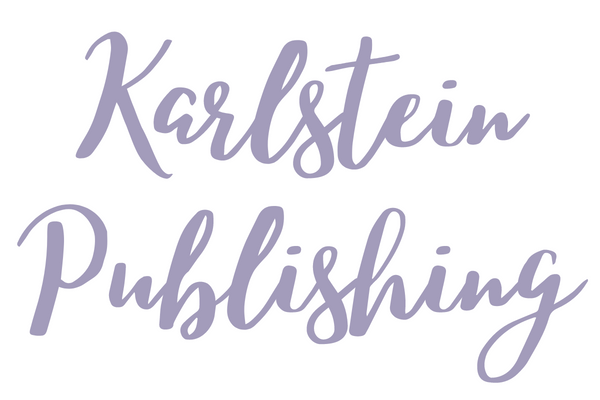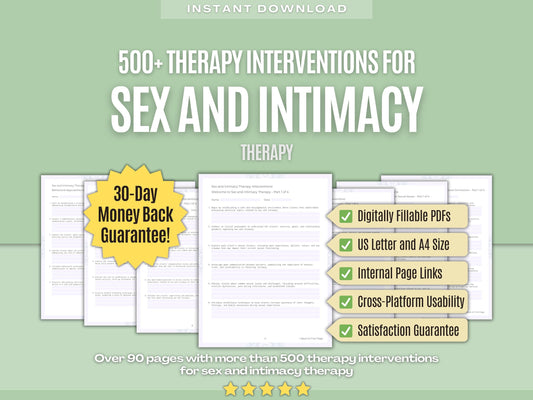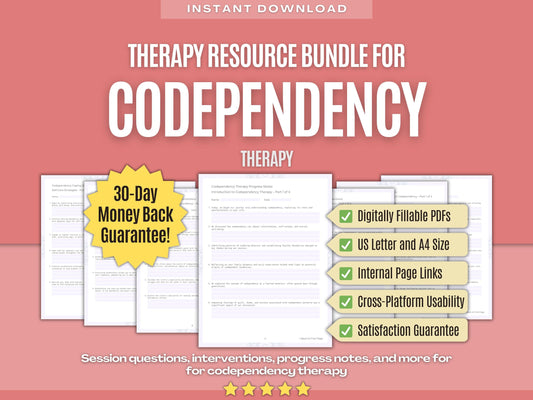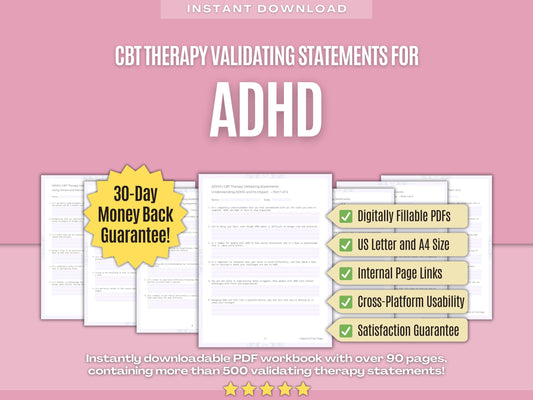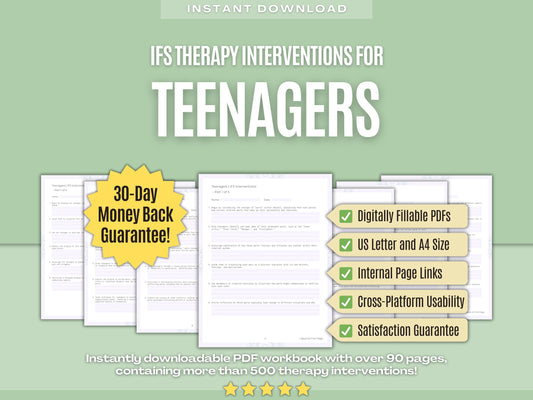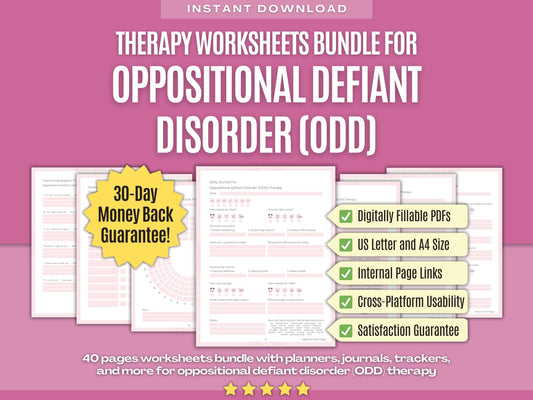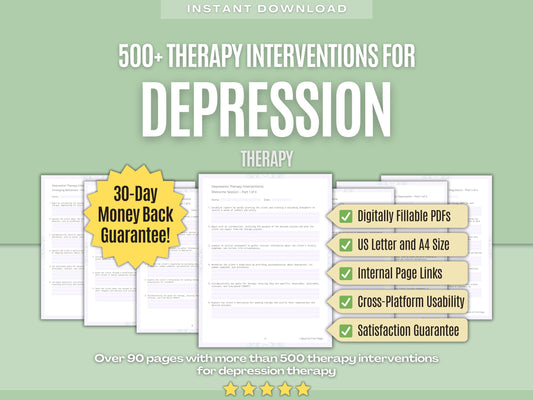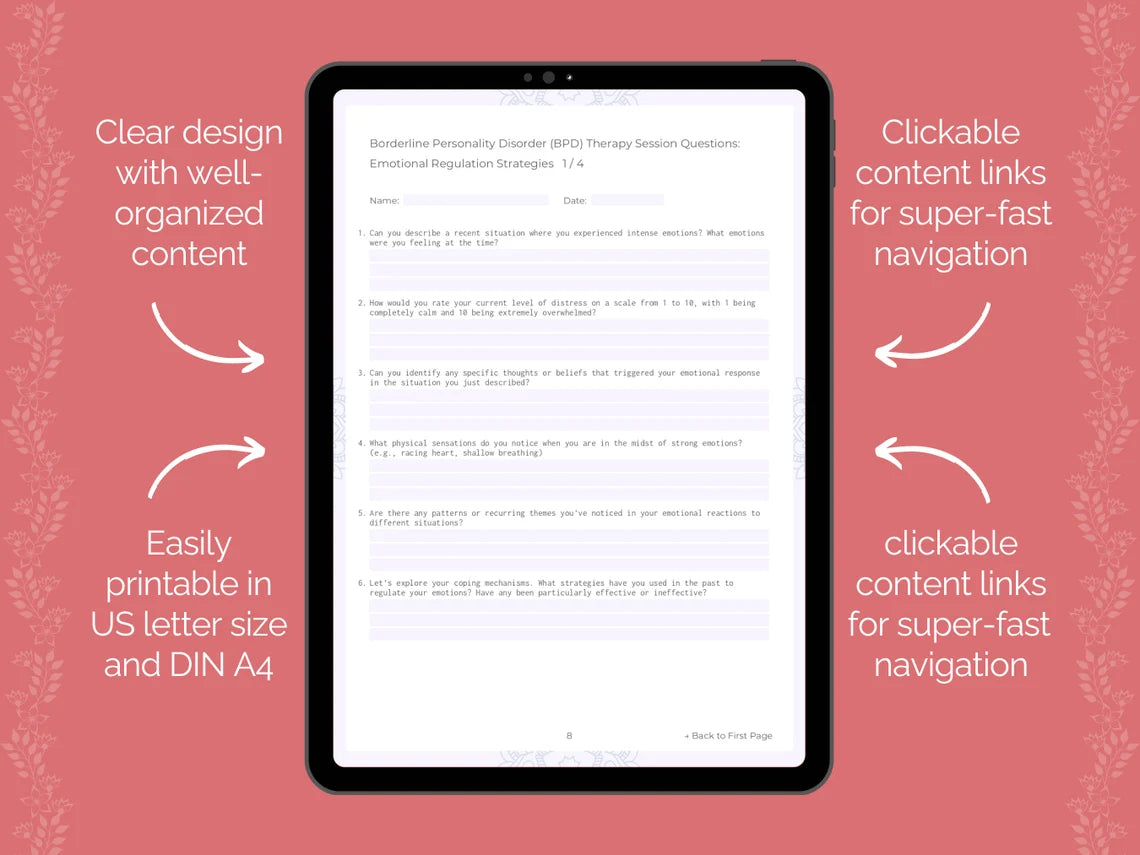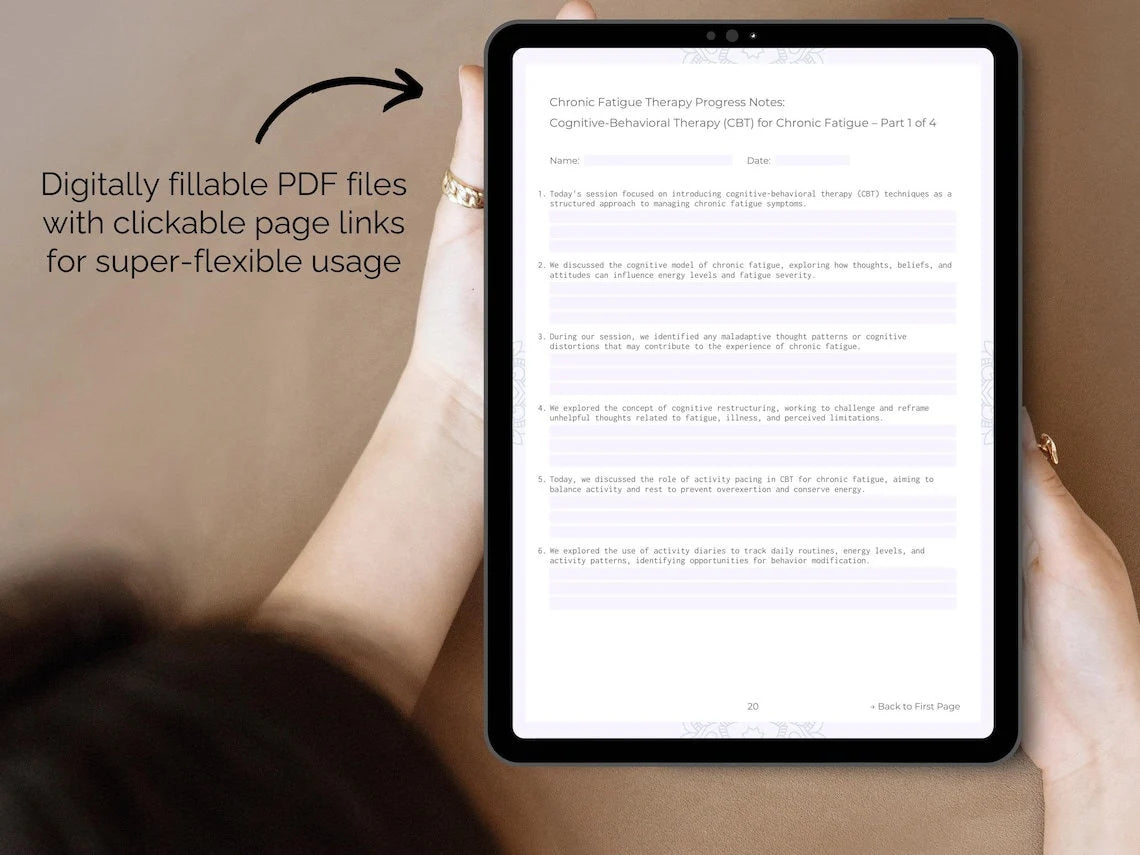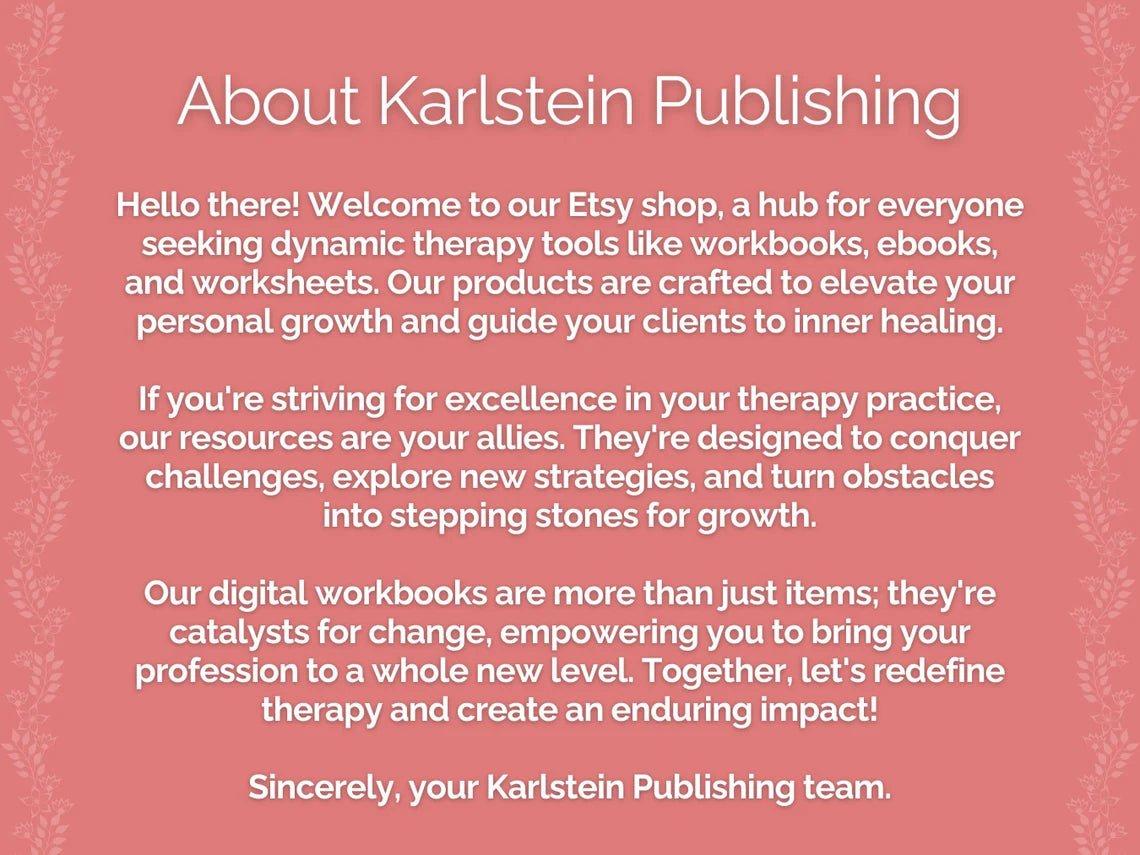Elevate Your Therapy and Guide Your Clients to Inner Healing with Our Autism Spectrum Disorder Therapy Interventions! ✨
1. Starting Autism Therapy
- Conducting an initial assessment to understand the individual's strengths, challenges, and goals.
- Educating caregivers about Autism Spectrum Disorder (ASD), including its characteristics, challenges, and available therapies.
- Collaboratively setting therapy goals with the individual and their caregivers, focusing on both short-term and long-term objectives.
- Implementing sensory integration techniques to address sensory sensitivities and support regulation.
- Teaching social skills through role-playing, modeling, and direct instruction, focusing on both verbal and nonverbal communication.
- Using visual supports such as social stories, picture cards, and visual schedules to enhance understanding and communication.
- Providing opportunities for structured and unstructured peer interactions to foster socialization and friendship skills.
- Encouraging participation in sensory-friendly activities and environments to promote comfort and engagement.
- Implementing mindfulness and relaxation techniques to promote self-awareness and stress management.
- Encouraging flexibility and adaptability through exposure to novel situations and changes in routine.
- Collaborating with educators and school personnel to implement consistent strategies and supports across settings.
2. Autism Psychoeducation
- Begin by explaining the concept of Autism Spectrum Disorder (ASD) to the individual and their caregivers, emphasizing its neurological basis and the wide range of characteristics it encompasses.
- Offer insights into the strengths associated with ASD, such as attention to detail, strong visual-spatial skills, and deep focus on specific interests.
- Address common myths and misconceptions about autism, clarifying misunderstandings and promoting acceptance and understanding.
- Provide information about the diagnostic process for ASD, explaining how assessments are conducted and the criteria used for diagnosis.
- Offer resources for further information and support, including reputable websites, books, support groups, and advocacy organizations.
- Explore the concept of neurodiversity and the idea that neurological differences, including autism, should be embraced and celebrated.
- Provide strategies for promoting positive relationships and communication between individuals with ASD and their peers, family members, teachers, and other community members.
- Offer guidance on how to create an inclusive and supportive environment for individuals with ASD, both at home and in the community.
- Address the challenges of transitioning to adulthood for individuals with ASD, including finding employment, living independently, and accessing adult services and supports.
- Provide practical tips for managing sensory sensitivities and creating sensory-friendly environments, including sensory diets and sensory-friendly accommodations.
- Discuss the importance of fostering self-esteem and self-advocacy skills in individuals with ASD, helping them recognize and embrace their unique strengths and abilities.
3. Mindfulness in Autism Support
- Begin by introducing the concept of mindfulness to the individual and their caregivers, explaining it as the practice of paying attention to the present moment with openness, curiosity, and acceptance.
- Offer a variety of mindfulness techniques tailored to the individual's preferences and sensory sensitivities, such as deep breathing exercises, body scans, and guided imagery.
- Encourage regular practice of mindfulness techniques, starting with short sessions and gradually increasing duration and complexity as the individual becomes more comfortable with the practice.
- Provide opportunities for mindfulness practice in different settings and contexts, including at home, school, therapy sessions, and community outings.
- Incorporate mindfulness into daily routines and activities, such as mealtime, bedtime, or transitions between activities, to promote consistency and integration into daily life.
- Integrate mindfulness into social skills training, helping the individual become more aware of their own emotions and the emotions of others during social interactions.
- Offer group mindfulness sessions to provide opportunities for peer support, shared experiences, and social learning.
- Integrate mindfulness into cognitive-behavioral interventions, combining mindfulness techniques with cognitive restructuring and problem-solving strategies.
- Encourage the use of mindfulness apps and digital tools designed for individuals with ASD, providing accessible and engaging ways to practice mindfulness independently.
- Incorporate mindfulness into sensory integration therapy, helping the individual regulate their sensory experiences and enhance body awareness.
- Explore mindfulness through creative expression, such as art, music, or movement-based mindfulness activities, tailored to the individual's interests and strengths.
4. Dialectical Behavior Therapy (DBT) for Emotional Regulation
- Begin by introducing the principles of Dialectical Behavior Therapy (DBT) to the individual and their caregivers, emphasizing its focus on developing skills for emotion regulation, distress tolerance, mindfulness, and interpersonal effectiveness.
- Teach mindfulness techniques to help the individual become more aware of their thoughts, feelings, and bodily sensations in the present moment, without judgment or reactivity.
- Use emotion regulation worksheets and diary cards to track emotions, identify patterns, and practice coping skills for managing emotional ups and downs.
- Teach grounding exercises, such as deep breathing, progressive muscle relaxation, or sensory grounding techniques, to help the individual stay anchored in the present moment during times of distress.
- Incorporate cognitive restructuring techniques to challenge and reframe unhelpful or negative thinking patterns that contribute to emotional distress.
- Use role-playing exercises and behavioral rehearsals to practice assertive communication, problem-solving, and conflict resolution skills in real-life situations.
- Provide opportunities for practicing emotion regulation skills in various contexts and situations, including at home, school, work, and social settings.
- Offer psychoeducation about the neurobiology of emotions and stress, helping the individual understand how their brain responds to different emotional triggers and how DBT skills can help regulate these responses.
- Incorporate mindfulness-based practices, such as body scans, mindful walking, or mindful eating, into daily routines to promote self-awareness and presence in the moment.
- Use validation techniques to acknowledge and empathize with the individual's emotional experiences, fostering a sense of connection and understanding within the therapeutic relationship.
- Collaborate with other professionals involved in the individual's care to ensure consistency and coordination of DBT interventions across different settings and contexts.
5. Interpersonal Therapy (IPT) for Social Skills
- Role-playing scenarios where the individual practices initiating conversations with peers, focusing on maintaining eye contact and appropriate body language.
- Engaging in group therapy sessions where the individual can practice social skills in a structured and supportive environment.
- Using visual aids such as social behavior maps to illustrate the consequences of different social behaviors and reinforce positive interactions.
- Teaching the individual strategies for recognizing and managing emotions in social settings, such as deep breathing or self-calming techniques.
- Practicing turn-taking and active listening skills through structured activities such as sharing circles or group discussions.
- Using social scripts to help the individual navigate specific social situations, providing them with ready-made phrases and responses.
- Organizing community outings or field trips to expose the individual to a variety of social environments and situations.
- Collaborating with parents and caregivers to reinforce social skills training at home and in other naturalistic settings.
- Incorporating social skills training into individualized education plans (IEPs) and academic goals, ensuring continuity across different environments.
- Role-modeling social skills during therapy sessions, demonstrating behaviors such as active listening, empathy, and problem-solving.
- Encouraging the individual to seek out social support networks, such as online forums or support groups, where they can connect with others who share similar experiences.
6. Emotion-Focused Therapy (EFT) for Emotional Awareness
- Encouraging the individual to identify and label their emotions using emotion cards or a feelings wheel to increase awareness of their emotional experiences.
- Using guided imagery techniques to help the individual visualize and explore the physical sensations associated with different emotions in a safe and supportive environment.
- Teaching emotion regulation skills, such as deep breathing, progressive muscle relaxation, or grounding techniques, to help the individual manage intense or overwhelming emotions.
- Utilizing emotion-focused coping strategies, such as expressive writing or art therapy, to help the individual process and express their emotions in a healthy and constructive manner.
- Encouraging the use of emotion-focused self-talk and affirmations to validate and reassure oneself during moments of distress or self-doubt.
- Providing psychoeducation about the physiological and psychological components of emotions, helping the individual understand the interconnectedness of mind and body.
- Facilitating emotion-focused mindfulness practices, such as loving-kindness meditation or body scan exercises, to cultivate compassion and acceptance towards oneself and others.
- Collaborating with the individual to develop personalized emotion-focused coping plans that outline strategies for managing specific triggers and stressors.
- Using emotion-focused visualization exercises to help the individual imagine and practice coping with future emotional challenges or difficult situations.
- Providing validation and empathy for the individual's emotional experiences, creating a supportive and validating therapeutic environment where emotions are accepted and understood.
- Encouraging the individual to engage in self-reflection exercises, such as journaling or mindfulness practices, to deepen their emotional awareness and insight.
7. Psychodynamic Approaches to Autism
- Exploring the individual's early childhood experiences and attachment dynamics to gain insight into the development of their sense of self and their interpersonal relationships.
- Examining the individual's patterns of relating to others and their internalized representations of relationships, known as object relations, to understand how these impact their social interactions.
- Exploring the individual's internal conflicts and ambivalence related to their diagnosis of autism, including feelings of self-doubt, shame, or identity confusion.
- Investigating the individual's experience of sensory sensitivities and hyper/hypo-reactivity through a psychodynamic lens to understand their emotional significance and underlying meaning.
- Examining the individual's use of repetitive behaviors or rituals as a means of managing anxiety, regulating emotions, or expressing unconscious desires or fears.
- Investigating the individual's experience of loss and grieving related to the perceived loss of neurotypicality or unfulfilled desires for social connection and belonging.
- Using therapeutic storytelling or guided imagery to help the individual explore and reframe their experiences of autism within a broader narrative of resilience and personal growth.
- Exploring the individual's patterns of resistance and defenses in therapy, helping them uncover unconscious barriers to self-awareness and growth.
- Exploring the individual's experience of social isolation and loneliness through a psychodynamic lens, examining underlying feelings of rejection, abandonment, or existential despair.
- Investigating the individual's experience of existential themes such as meaning, purpose, and mortality in relation to their diagnosis of autism, exploring existential anxieties and sources of existential fulfillment and meaning.
- Using psychodynamic interpretations to explore the individual's internalized narratives and schemas about themselves and their autism diagnosis, working towards fostering greater self-awareness and self-compassion.
8. Music Therapy for Communication and Connection
- Using improvised music-making activities such as call-and-response or musical dialogue to promote turn-taking, joint attention, and communication skills in individuals with autism spectrum disorder (ASD).
- Incorporating structured music activities such as singing songs with repetitive lyrics or familiar melodies to facilitate language development and verbal communication in individuals with ASD.
- Providing opportunities for individuals with ASD to engage in music improvisation and composition, allowing them to create their own musical narratives and express themselves creatively.
- Incorporating music therapy interventions into speech and language therapy sessions to enhance speech production, articulation, and receptive language skills in individuals with ASD.
- Incorporating movement-based activities such as dance or movement games into music therapy sessions to promote gross motor skills, body awareness, and social engagement in individuals with ASD.
- Using music as a tool for social storytelling, allowing individuals with ASD to create and perform musical narratives that reflect their experiences, interests, and emotions.
- Incorporating music therapy interventions into educational settings to support academic learning and cognitive development in individuals with ASD, such as using songs to teach concepts or mnemonics to aid memory.
- Providing opportunities for individuals with ASD to engage in music-based play activities such as musical games, instrument exploration, and movement activities to promote social interaction and peer bonding.
- Incorporating music-based interventions into behavioral therapy sessions to promote positive behavior reinforcement and emotional regulation in individuals with ASD.
- Using music as a tool for building self-esteem and confidence in individuals with ASD, providing them with opportunities to showcase their musical talents and accomplishments.
- Using music as a means of facilitating transitions and routines in individuals with ASD, such as using songs or musical cues to signal changes in activities or transitions between environments.
9. Concluding Therapy Sessions for Autism
- Reviewing the key insights, skills, and strategies discussed during the therapy sessions to reinforce learning and promote retention.
- Collaboratively setting goals for future growth and development, identifying areas for continued focus and improvement.
- Providing psychoeducation about autism spectrum disorder (ASD) and related topics to increase understanding and awareness.
- Normalizing setbacks or challenges experienced during therapy, emphasizing that they are a natural part of the learning and growth process.
- Discussing strategies for managing stress, anxiety, or other emotional difficulties that may arise after therapy sessions end.
- Exploring feelings about the conclusion of therapy and addressing any fears or anxieties about ending the therapeutic relationship.
- Discussing strategies for maintaining healthy boundaries and relationships in various contexts, such as at home, school, or work.
- Encouraging the individual to continue advocating for their needs and seeking out support when necessary.
- Exploring any changes in the individual's self-perception or identity that may have occurred during therapy.
- Reiterating the therapist's commitment to the individual's well-being and offering ongoing support as needed.
- Exploring strategies for maintaining connections and relationships established during therapy, such as staying in touch with peers or mentors.
10. Reflections on Autism Therapy Journey
- Reflecting on the initial goals and objectives set at the beginning of the therapy journey, comparing them to the progress made and the outcomes achieved.
- Celebrating successes and milestones reached throughout the therapy journey, acknowledging the individual's growth, development, and accomplishments.
- Discussing the impact of therapy on the individual's life, relationships, and overall well-being, exploring positive changes and areas of continued growth.
- Exploring any shifts in self-awareness, self-acceptance, and self-esteem that occurred as a result of therapy, discussing changes in self-perception and identity.
- Examining the role of support systems, including family, friends, and other professionals, in the individual's therapy journey, reflecting on the importance of collaboration and teamwork.
- Reflecting on the individual's experiences with sensory sensitivities and challenges, discussing coping strategies and accommodations that were helpful during therapy.
- Reflecting on the individual's experiences with change and transitions, discussing strategies for managing transitions and adapting to new situations.
- Reflecting on the individual's experiences with self-regulation and emotional expression, discussing strategies for managing emotions and promoting emotional well-being.
- Reflecting on the individual's experiences with identity and self-concept, discussing shifts in self-understanding and acceptance of neurodiversity.
- Reflecting on the individual's experiences with play and leisure activities, discussing opportunities for creativity, exploration, and enjoyment.
- Reflecting on the individual's experiences with advocacy and self-advocacy, discussing ways to advocate for one's needs and rights in various contexts.
We hope that our therapy interventions for Autism Spectrum Disorder therapy will help you to elevate your therapy practice and guide your clients to inner healing! Do you need more therapy interventions for Autism Spectrum Disorder therapy? Find them all in our Digital Workbook! Or do you have any questions or suggestions for us? Please feel free to contact us at any time!
